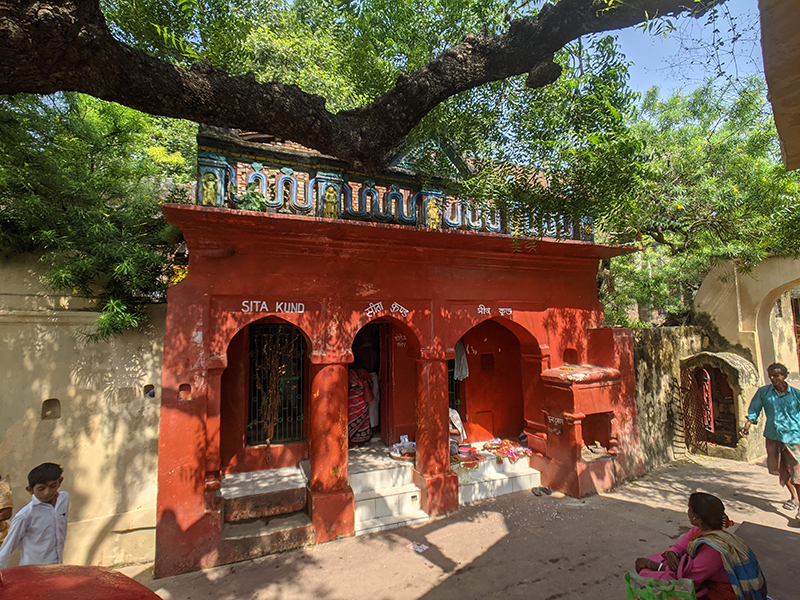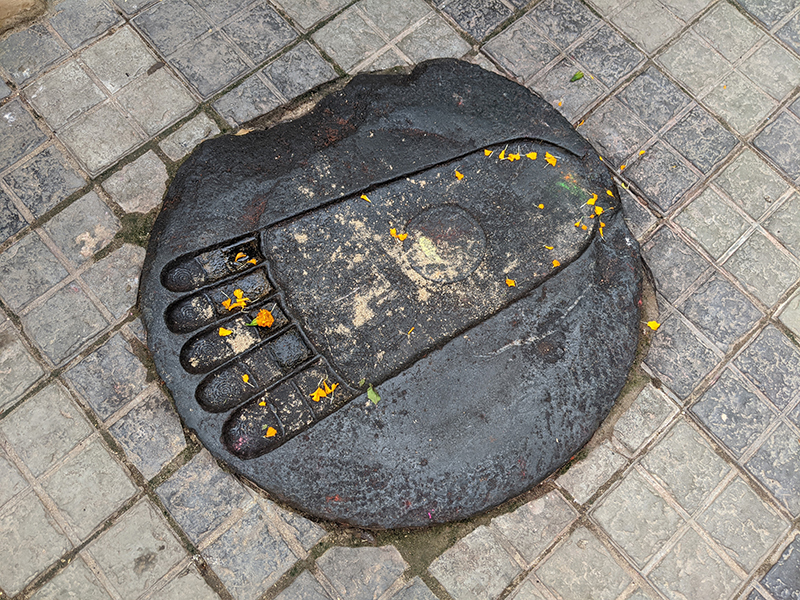
Sita Kund in Gaya is the place where Sita Devi did the pind-daan offering to King Dasharatha. Located on the eastern bank of the Falgu river in Gaya city of Bihar, India, it is one of the most important holy sites in Gaya.
Not just Sita Devi but Lord Rama and Lakshmana too had set their lotus-feet here. Though there are Sita Kunds elsewhere including the one at Munger in Bihar, the Sita Kund in Gaya has its own distinct identity.
The Gupt Ganga river flows here beneath the sand on the banks of the Falgu river. You can dig a small hole in the sands with your bare hands to see the sacred waters of the Gupt Ganga.
In the historical temple of Sita Kunda is the Deity of Sita Devi and King Dasharatha’s hand accepting pinda. There is one pinda in the hand of King Dasharatha and the remaining two pindas are kept by the side. The temple is located on the left side as you enter the main gate from the ghat on the Falgu river bank.
Lila of Sita Kund
The Sita Kund in Gaya is famous as the sacred spot where Sita Devi offered pind-daan to King Dasharatha. Lord Rama and Sita Devi had gone to Gaya to perform the pind-daan for King Dasharatha. At that time, the region where the Sita Kund is present now was a forest.
Lord Rama went across the Falgu river to get the materials needed to perform the pind-daan. In that time-period, Sita Devi took a bath, offered prayers and made three sand balls with water for worshipping Lord Shiva and Parvathi Devi.
The time was getting lapsed, the sun was about to set. Maharaja Dasharatha became worried if the pinda could be offered to him within the stipulated time. Suddenly, King Dasharatha spoke from the sky requesting Sita Devi to perform the pind-daan. Hearing this, Sita Devi asked as to how She could perform the pind-daan in Her husband’s absence.
King Dasharatha said that women could offer pind-daan from now on in the same way as men could do. She did not have anything to offer to Maharaja Dasharatha except the sand balls. He told Sita Devi to offer sand ball itself as the pinda to him. Listening to this, Sita Devi offered pinda to King Dasharatha. Two hands appeared from the ground and accepted the offering of Sita Devi.
When Lord Rama came back, Sita Devi narrated the course of events that happened in His absence and how She had offered pinda to King Dasharatha. Hearing this, Lord Rama asked for testimonials from witnesses proving the same.
Sita Devi curses Phalgu River
Sita Devi asked the Falgu river, the Tulasi plant, the cow, the banyan tree and a brahmana who were present at that time to bear witness. With the exception of the banyan tree, everyone else lied for their own benefit. This enraged Sita Devi who cursed all the witnesses with the exception of the banyan tree.
Sita Devi cursed the Falgu river to flow under the ground, the cow was cursed to be worshipped only from the rear instead of the face, the Tulasi plant would be the best amongst bushes and worshipped everywhere but would dry out very quickly and that the brahmanas of Gaya would never be satisfied. When Sita Devi cursed these four personalities, they realized their mistake. Apologizing to Sita Devi, they all bore witness to King Dasharatha’s pind-daan.
After Lord Rama was convinced of the pind-daan to His father King Dasharatha by His consort Sita Devi, the place became famous as Sita Kund. The Falgu river flows very lightly generally except during the rainy season due to the curse of Sita Devi.
Brahma’s Pada at Sita Kund
This place also contains the impression of Brahma’s pada which was imprinted when all of them stood on the body of Gayasura while Brahma performed the Yajna.

How to Reach Sita Kund
If you are planning to visit this holy spot connected with the Ramayana, simply hop on the Ayodhya-Kashi Yatra conducted by Tirtha Yatra. You’ll love it!
Visiting Sita Kund requires you to reach the city of Gaya first. You can walk over the Falgu river from the ghat beneath the Vishnupada temple to reach Sita Kunda if you intend to visit the Vishnupada temple first. Being a rainy river makes it easier to cross the river on foot.
Based on your circumstances, you may choose the following means to reach Gaya –
By Road: Buses and private taxis are available from Patna and other cities in neighboring states.
By Rail: The Gaya railway junction serves the city through its connection to important metros such as New Delhi, Kolkata and Mumbai. Direct trains between Gaya and other important cities such as Varanasi, Ranchi, Lucknow, Kanpur, Puri, Nagpur, etc. are also available.
You can catch a private taxi to the temple from Gaya railway junction.
By Air: The Jayprakash Narayan International Airport at Patna is the nearest airport 122 kms away. You can fly in here and use the rail or road route to reach the temple.
0










Leave a Reply